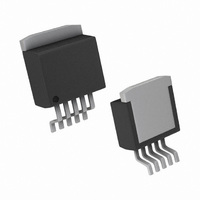LP3856ESX-5.0/NOPB National Semiconductor, LP3856ESX-5.0/NOPB Datasheet - Page 14

LP3856ESX-5.0/NOPB
Manufacturer Part Number
LP3856ESX-5.0/NOPB
Description
IC REG LDO 3A 5.0V TO-263-5
Manufacturer
National Semiconductor
Datasheet
1.LP3856ES-3.3NOPB.pdf
(18 pages)
Specifications of LP3856ESX-5.0/NOPB
Regulator Topology
Positive Fixed
Voltage - Output
5V
Voltage - Input
Up to 7V
Voltage - Dropout (typical)
0.39V @ 3A
Number Of Regulators
1
Current - Output
3A (Max)
Operating Temperature
-40°C ~ 125°C
Mounting Type
Surface Mount
Package / Case
TO-263-5, D²Pak (5 leads + Tab), TO-263BA
Lead Free Status / RoHS Status
Lead free / RoHS Compliant
Current - Limit (min)
-
Other names
LP3856ESX-5.0
www.national.com
SHUTDOWN OPERATION
A CMOS Logic low level signal at the Shutdown (SD) pin will
turn-off the regulator. Pin SD must be actively terminated
through a 10kΩ pull-up resistor for a proper operation. If this
pin is driven from a source that actively pulls high and low
(such as a CMOS rail to rail comparator), the pull-up resistor
is not required. This pin must be tied to Vin if not used.
The Shutdown (SD) pin threshold has no voltage hysteresis.
If the Shutdown pin is actively driven, the voltage transition
must rise and fall cleanly and promptly.
DROPOUT VOLTAGE
The dropout voltage of a regulator is defined as the minimum
input-to-output differential required to stay within 2% of the
nominal output voltage. For CMOS LDOs, the dropout voltage
is the product of the load current and the Rds(on) of the in-
ternal MOSFET.
REVERSE CURRENT PATH
The internal MOSFET in LP3853 and LP3856 has an inherent
parasitic diode. During normal operation, the input voltage is
higher than the output voltage and the parasitic diode is re-
verse biased. However, if the output is pulled above the input
in an application, then current flows from the output to the
input as the parasitic diode gets forward biased. The output
can be pulled above the input as long as the current in the
parasitic diode is limited to 200mA continuous and 1A peak.
POWER DISSIPATION/HEATSINKING
LP3853 and LP3856 can deliver a continuous current of 3A
over the full operating temperature range. A heatsink may be
required depending on the maximum power dissipation and
maximum ambient temperature of the application. Under all
possible conditions, the junction temperature must be within
the range specified under operating conditions. The total pow-
er dissipation of the device is given by:
P
where I
(specified under Electrical Characteristics).
D
= (V
IN
GND
−V
OUT
is the operating ground current of the device
)I
OUT
+ (V
IN
)I
GND
FIGURE 4. Improving remote load regulation using LP3856
14
The maximum allowable temperature rise (T
the maximum ambient temperature (T
and the maximum allowable junction temperature (T
T
The maximum allowable value for junction to ambient Ther-
mal Resistance, θ
θ
LP3853 and LP3856 are available in TO-220 and TO-263
packages. The thermal resistance depends on amount of
copper area or heat sink, and on air flow. If the maximum al-
lowable value of θ
package and
needed since the package can dissipate enough heat to sat-
isfy these requirements. If the value for allowable θ
below these limits, a heat sink is required.
HEATSINKING TO-220 PACKAGE
The thermal resistance of a TO220 package can be reduced
by attaching it to a heat sink or a copper plane on a PC board.
If a copper plane is to be used, the values of θ
as shown in next section for TO263 package.
The heatsink to be used in the application should have a
heatsink to ambient thermal resistance,
θ
In this equation, θ
to the surface of the heat sink and θ
tance from the junction to the surface of the case. θ
3°C/W for a TO220 package. The value for θ
method of attachment, insulator, etc. θ
C/W to 2.5°C/W. If the exact value is unknown, 2°C/W can be
assumed.
HEATSINKING TO-263 PACKAGE
The TO-263 package uses the copper plane on the PCB as
a heatsink. The tab of these packages are soldered to the
copper plane for heat sinking.
θ
a typical PCB with 1 ounce copper and no solder mask over
the copper area for heat sinking.
JA
HA
JA
Rmax
≤
= T
of TO-263 package for different copper area sizes, using
θ
= T
Rmax
JA
Jmax
− θ
/ P
CH
− T
≥
D
− θ
60 °C/W for TO-263 package no heatsink is
Amax
JA
JA
CH
JC
calculated above is
, can be calculated using the formula:
.
is the thermal resistance from the case
Figure 5
Amax
JC
CH
≥
shows a curve for the
is the thermal resis-
varies between 1.5°
60 °C/W for TO-220
) of the application,
20030908
Rmax
CH
JA
) depends on
will be same
depends on
JC
Jmax
is about
JA
):
falls









